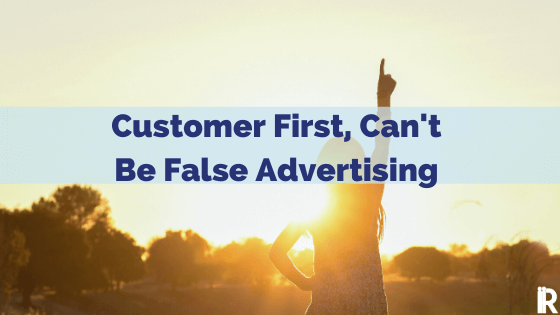Is your organization really putting the customer first?
If you talk to any organization, they will always tell you that the customer is their first priority. It’s who they serve. It’s why they get up in the morning. It’s their reason for being in business. It all sounds good, if it’s true.
The problem is these are cliches. And not worth the poster paper they’re printed on in your boss’s office if your organization doesn’t actually put those words into consistent action.
In the last few months, I’ve experience two encounters that illustrated how hollow those words can be. (Weirdly, both telecommunications companies)
MOBILE SERVICE
I have had a hard time keeping my costs down with my mobile provider. I just can’t seem to keep my data usage down. I know I get a pretty great base deal, but I also over work my data plan to the point where I’m paying 2x to 3x what the bill should be. Not great. And something I really needed to address. Either I could use my phone less (not likely) or I could contact my mobile service provider and see if I could change to another plan or something, anything. I chose the later, so I headed out to the local branch of my provider and ask if I could switch to a plan that might work better for me. And I certainly didn’t mind paying a bit more now if it meant the over-usage costs were a lot manageable.
Once I met with an associate, they took my information and pulled up my account.
“It says here you have a 2G max on your account.” – associate
“Yeah, I’m maxing out on that way too often and it’s killing me.” – me
“You know, I can switch you to a 10G max for the same price. You have an old plan that we’ve grandfathered in.” – associate
“An old plan that makes me pay more. Yeah, I’ll go with the new plan.” – me
Sigh.
I have no problem with plans being grandfathered in if their at a better cost to the customer. However, if it penalizes the customer, shouldn’t they know there’s a better plan for them that wasn’t offered before?
INTERNET PROVIDER
My internet was sloooooow. I did a few of those speed tests that measure how effective your download and upload times. Mine? Not so great. I remember buying a decent plan for my internet, not the most expensive but a few tiers higher than the lowest option. It was going so slow however that I absolutely needed to talk to my provider.
It wasn’t long before I was in the same conversation as the mobile service one. “Can I get your information. Oh hey, we don’t offer that plan anymore. We can move you to a much better plan at the same cost.”
When I challenged the operator as to why I didn’t know about this new offering, her answer was that I couldn’t expect them to email everyone about the new plan. That’s too much work.
Too. much. work. To serve their customers and better inform them about the services you provide.
So these organizations introduce new plans for their new customers, without informing their existing (loyal?) customers of these changes. Changes, that not only could save the customer a lot of money but also build a stronger connection to a company that has their best interests at heart. Instead, they wait for their customers to figure out they are paying too much and then wait for them to come in or call to address it. How is this serving the customer? Now is this putting the customer first? It’s either laziness or intent to only serve the bottom line. It’s not customer-centric.
WHAT SHOULD BE DONE
1) Communicate with your customers and communicate again – informing your customers about any changes that may affect them is vital to maintaining trust and a relationship. One of the most important tools you can use is a customer relationship management (CRM) system, which could segment your customers by the particular plans they are on. Filter them out and send an email their way, showing them you actually care about your business relationship and their pocket book. If not very many people take advantage of the change, communicate again with a much more urgent (and possibly better written) email. You can’t over communicate.
2) Show them you care – if your customers aren’t alerted to the new plans, and they instead come across the change themselves, give them something to show you’re sorry you couldn’t connect with them and that you value them. Perhaps a month free. You’ve already gotten more money out of them (which will either make them feel stupid or taken advantage of) so here’s an opportunity to show some empathy. Make use of it.
3) Define who you serve – this might not be popular but it certainly will get rid of any confusion. Look at your practices and define who you really serve. It could be a board, it could be your executive, it could be the almighty dollar, it could be the media, and it really could be your customers. But by defining who you are truly serving, it’ll make decisions and actions far easier to understand and make. Though it may impact your vision/mission statements.






